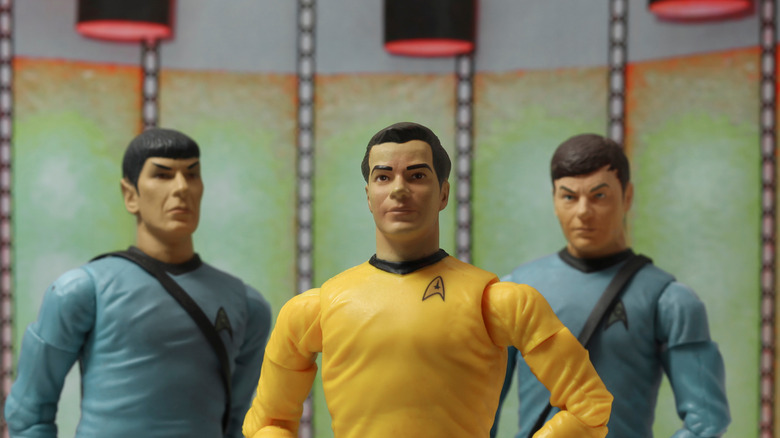The Creative Ways Star Trek Tried To Save Money
The popular sci-fi show "Star Trek" debuted more than 50 years ago and would end up having one of the biggest cult followings in pop culture. The first episode aired in September 1966 and was titled "The Man Trap." The creators of the show likely didn't foresee it then, but this would be the beginning of a series that turned into a franchise, and later an influential show that helped shape the future of sci-fi in Hollywood. A revival of the show in the late '80s helped cement a place for the show, which would later spawn more shows and even films.
Discover Los Angeles tells us that the show was filmed on the Desilu-Gower studios lot (eventually owned by Paramount Studios) – the series' home for three years. In 1966, when the show was in its early stages, the Los Angeles Times reported that "Trek" was the most expensive production at the time. Per MeTV, filming a single episode of the show reportedly cost $200,000. Today that would translate into $1.6 million (via the In 2013 Dollars inflation calculator). So while looking back, the episodes of "Star Trek" may have looked low-budget, but in reality the show came with a hefty price tag. Subsequently, the producers took several measures to be more economical.
The teleportation device
One of the biggest money-saving efforts by the show's production team would also turn out to be something the show was well-recognized for, and it all started during the debut year. In the "Star Trek" world, which is based in space in the 23rd century, a captain and his crew embark on various voyages to worlds unknown to Earth. Their mode of travel is the starship — a massive spacecraft. When reaching new territory, the show needed to portray crew members moving between their ship and these new planets. But repeatedly showing a ship landing every episode — on a show where literally every week there was a new discovery — would've been costly, says Comic Book Resources.
To save money (and time), a new concept came about as a workaround. The transporter, a teleportation machine, is known to Trekkies (or Trekkers, if you prefer) as the device that transported crew members from the ship to a planet down below. On television it worked perfectly, because one minute a cast member was on screen, but then stepped into the device and slowly disappeared to reappear in another scene. The limited funding motivated the creation of a "Star Trek" mainstay.
Star Trek stays frugal
That wasn't the only cost-effective measure the show had to do to save money. Of course on a sci-fi show based in space, there were several futuristic gadgets that were shown. Some of these devices were introduced as one thing, only to be reseen and reintroduced as something else in a later episode. And who else would notice these, other than hardcore Trekkies? According to the Trek BBS site, props weren't the only things to get recycled; background characters' costumes also appeared in other episodes, worn by other actors.
Time is money, of course, in TV production as everywhere else. When every dollar counted, being able to re-use/repurpose materials made sense. The idea wasn't just limited to props and costumes, either. Production team also used footage from previous episodes and blended them into newer ones. In the franchise shows that followed, if you saw a certain scene in one episode, you could see it again in another. Per WhatCulture, there are close to a dozen instances of this.


